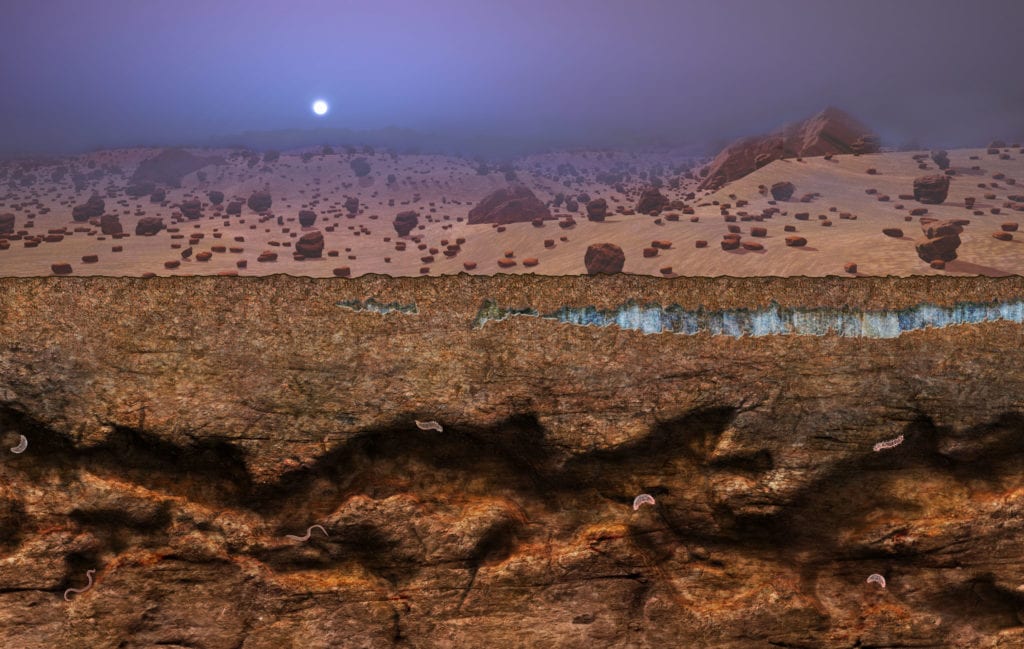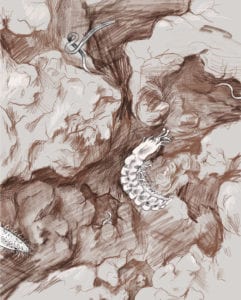Mars Life Magazine Science Illustration

Industry: Magazine Publisher
Art director: Terri Dube
Subject: Life on Mars, Science Illustration
Sky and Telescope Issue
Mars Life Science Illustration Goal and Challenges
Sky and Telescope magazine approached SayoStudio’s Nicolle R. Fuller to create an eye-catching cover and accompanying feature illustration spread showing potential life on Mars. Recent discoveries, both here on Earth and on Mars, suggest that there may be underground tunnels capable of supporting Martian life. To be authentic to the well-versed, loyal readership of Sky and Telescope magazine, the illustration needed to be strongly grounded in science while also eye-catching enough on the newsstand for new readers to pick up a copy.
Since we humans first realized that planets beyond ours are scattered among the stars, we’ve been fascinated with the possibility that alien life exists. But it seemed unlikely. Fortunately for all the dreamers out there, science has caught up to our imaginations and the likelihood of life seems to be more and more a certainty. Here on Earth, the continued discovery of life in extreme environments—in acidic hot pools, near radiation, in mines so deep the sun’s energy doesn’t reach—gives us more clues as to where these organisms may thrive on other planets.
(See Topic Magazine’s Feature on Extremophiles for more information and artwork from Nicolle)
Mars Life Illustration Process and Solution
First, Nicolle reviewed the reference materials that Sky and Telescope provided, including recent discoveries of eukaryotes, worms, and nematodes living miles underground, far from sunlight, in deep South African Mines. Then, she had a conference call with the editorial team and art director Terri Dube. They wanted the cover and the interior spread illustration to play off of and inform one another. The feature art would show the full Martian landscape with a cutaway to reveal underground tunnels, while the cover would be a close-up view of the microbes. Despite showing a close-up, the cover still needed to give the feeling of being deep underground.
“The feature is about the possibility of life underground on Mars. The two illustrations will play off each other…the cover being an up-close look at some microbes that could be living underground on Mars and the article opener showing a cross section of land where you see them in the tunnels below ground where they live. So the effect should be seeing details of the microbes on the cover and then them in their below ground space for the opener.” ~ Terri Dube
Mars Life Feature Illustration Creation
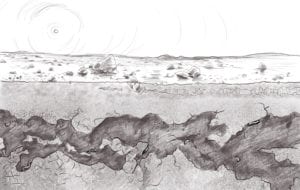
Starting with the feature art, Nicolle sketched out the Mars landscape she and the team had discussed. Astronomers are still learning about Mars: it’s possible there are both caves formed by lava, and smaller tunnels and fissures from freezing water. So she focused on showing the potential variability in the tunnels, with different sizes and depths, and cracks extending from them. At this scale micro-organisms would be tiny on the page, so the visual interest needed to come from the landscape and tunnels. The detailed maze of tunnels helped to ground the art.
Next, Nicolle started thinking about the overall Martian landscape. Like many of you, she had a pretty clear idea of what a Martian landscape might look like. But she wanted to be sure this vision was based on reality rather than on science fiction that she may have inadvertently digested. A search through NASA images from Mars Rovers provided a feel for the rocky landscape. When drawing Earth landscapes, Nicolle experiments with setting the mood with the sky and clouds. On Mars there aren’t fluffy white clouds or looming thunderstorms. Instead, it’s a bit of a monotonous haze. Considering how to capitalize on this dusty atmosphere, Nicolle wondered what a Martian landscape might look like at sunset. She landed on a slightly purple to orangish gradient that she felt made the piece unique. The Sky and Telescope team agreed that the otherworldy hue suited the piece.
Creating the Color Art Martian Life feature
With a vision in mind and confirmation on direction from Sky and Telescope, Nicolle started creating the color art. She used Eon Vue’s 3D landscape program to build the rocky terrain. The underground tunnels were sculpted in Zbrush to match the earlier sketch. Nicolle combined these two pieces in Photoshop and hand-drew in more cracks and texture. Initially, the above-ground colors were exaggerated, and the rocks lightened. Terri Dube liked it but asked to push it toward somewhat more realistic lightning. The landscape was re-worked with deeper shadows and a less-saturated sky.
Mars Life Cover Illustration Creation Process
Nicolle’s approach to the interior art was similar to that of the cover. In the rough sketch for the editorial team she purposely drew more advanced creatures than the typical one-celled bacteria we’ve recently guessed alien life to be—taking cues from shrimp-like arthropods and nematodes discovered in deep South African mines. S&T loved where it was going, but they suggested that the center organisms not be quite so identifiable as an Earth species. (A little artistic license within the realm of science illustration is always fun!) Also, they suggested that we have a little fun with the top worm, and weave it into the ampersand of Sky & Telescope.
Mars Life Cover Sketches
After fine-tuning the sketches, Nicolle was on to the color art fun. Again, she used Zbrush to sculpt the rocky cover. She really wanted to physically model the dark and light shadows from deep tunnels and holes, rather than merely replicating it in a drawing. Texture brushes worked well for physically stamping out the rough stone and adding tiny imperfections. To add to the Martian rocky close-up, Nicolle continued texturing with Cinema 4D and with hand-drawn crack details in Photoshop.
Creating the Color Art for the Martian Life Cover Illustration
Finally, Nicolle got to 3D model the creatures I envisioned in Cinema 4D. She created translucent materials for their bodies that the orangish lights could shine through to pick up the colors of the surrounding rocks.
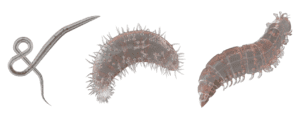
“The microbes should be translucent and pick up the colors around them: orange, brown, reddish tones from the Martian landscape. We would like some of the textural details that appear in the research paper image to come through and I thought the way you stylized the octopus in your attached illustration was beautiful.” ~ Terri Dube
Now all the pieces were ready to bring into Photoshop and blend into the final piece. If you look closely, you’ll see one key change that we made from the last sketch!

